
One thing I really like to do is draft good sets. While most cubes provide a unique experience in which you get to play with a wide variety of powerful cards from various sets, there is something about a well-designed and playtested Limited environment that far outshines the enjoyment of having to decide between [card]Jace, Architect of Thought[/card] and [card]Jace, Memory Adept[/card]. Personally, I prefer the questions like [card]Murderous Cut[/card] versus [card]Highspire Mantis[/card] or [card]Seeker of the Way[/card] versus [card]Abzan Battle Priest[/card]. I also vastly enjoy the weaker decks that these formats create as they are more about Magic fundamentals than having ways to outplay your opponent’s deck. I also really like Khans of Tarkir and have decided I’d like to draft it in the future.
The issue with drafting sets is that it is fairly costly. Here at Casually Infinite, we are all about value. While I’m willing to pay $15 once every couple months to sit around and draft, I’d much prefer to be able to do so whenever I want without a cost. There are also some formats that I’d love to be able to draft that I’m even less willing to purchase the packs for. I can’t go back and draft Innistrad unless someone pulls out a box from their vault or I shell out five bucks a pack, either of which isn’t very likely to happen. If I want to be able to draft Khans in the future, I’m going to need to pick up two boxes for every three drafts I want to fund. I’ll have to sink $200 at least, with a best possible result of being able to draft three times. I’m not thrilled with that result.
I’ve decided to look at preserving the Khans draft environment in a cube. Having a cube of Khans would allow me to essentially draft the format whenever I wanted without any ongoing fee. I could even test Sealed deck builds, or even Team Sealed practice builds, from the cube. While cubes are substantially different from a regular set in a number of ways, there’s some steps we can take to mitigate the impact and have our cube play out more like opening boosters. In this article, I’ll be spelling out some of the ways to cube a set and how those ways affect how the overall cube plays out.
Full Set Cubed
While cubes generally only have one of each card, Khans only has 249 cards. Picking up a full set would create a pretty pathetic cube, capable of supporting only five drafters. When Fates Reforged comes out, I could combine the two sets into one 434-card cube. This gets us across the important 426 line needed to run eight 14-card draft packs. But there’s always a chance I won’t be that fond of Fates Reforged—and I do really like the Khans set. One of the quickest ways I could build a cube with it is pick up two complete sets of Khans. This gives me almost 500 cards.
One problem with running a cube like this, besides the cost (which would be around $400), is that it won’t play anything remotely like the current Khans limited environment. With a cube made from two complete sets, we’d see see a one-to-five ratio of rares to other cards, uncommons would be almost as numerous as commons, and an average draft pack would contain one mythic. While this would be a way to play Khans, I don’t feel it really captures the environment for the future. I’m also relatively sure that in this draft environment, solid Limited cards like [card]Archer’s Parapet[/card] and [card]Monastery Flock[/card] would never see play, and I actually like those cards. If I want to capture the Khans Limited environment, I’m going to need to work closer to what can actually be found in a booster pack.
Building Boosters
One option that I’m not very fond of is manually building boosters from random cards in Khans. While this can be one of the cheapest ways to exactly replicate the Limited environment, the process of putting together one rare/mythic, three uncommons, and ten commons is incredibly time consuming. While this is probably the most accurate way to directly replicate the Limited environment, the idea of sorting some 500 cards into piles by rarity, then manually reassembling boosters makes the entire project sound far less enjoyable. I’ll admit that there may be some times that I’d consider this such as testing for a Team Sealed event, but overall I’d rather just build a cube that closely replicates what is likely to be found in boosters. If you don’t mind resorting after each draft, this is going to be the best way to go.
Khans has 101 commons, 80 uncommons, 53 rares, and 15 mythics. The current ratio of cards found in packs is 10 commons, 3 uncommons, 7/8 rare, 1/8 mythic. Each draft contains 24 boosters, meaning every draft will contain 240 commons, 72 uncommons, and an average of 21 rares and three mythics. Trying to replicate a self-contained cube with almost this exact ratio requires a huge number of cards. You’d need ten copies of each common, four copies of each uncommon, two copies of each rare, and one copy of each mythic—for a grand total of a 1451 cards in your cube. This brings a slightly higher percentage of rares (about one percent more than normal) and slightly fewer commons (two percent fewer commons) but lets you use every single card found in the set. I can’t imagine trying to shuffle this, much less lug it around. It doesn’t seem very realistic to me.
Cube Options
One of the first things I note about wanting to build a cube around a set is that I’m trying to capture the feel of a set, not necessarily capture an exact replica of the Limited environment. This means a few things. First off, I want it to play similar to the Limited environment, but not necessarily exactly the same. This means I don’t actually have to include every card. Personally, I wouldn’t feel like the Limited environment was being messed up if there wasn’t a single copy of [card]Lens of Clarity[/card] in my cube. That card is awful. If I really wanted to include one, I could probably just stick a singleton in to preserve the feel, as I wouldn’t need a full playset of them in order to feel like I’m capturing Khans. Now, getting my hands on five copies of [card]Lens of Clarity[/card] isn’t going to be hard, but the same theory can be held with rares and mythics.
The second issue building the cube really comes with the mythic rares. With 53 rares and 15 mythics, the ratio is substantially off and the only way to fix it and replicate the environment would be to get two copies of each rare to go along with the mythics. What I don’t like about this option is the cost. Even if we’re only looking at a dollar a rare, this is still adding $50 to the cost of my cube, and there happens to be many-high cost rares. There are two ways around this. The easy way is just to consider mythics as rares and have one of each rare and one of each mythic. This skews the cube towards a greater number of more powerful cards, as the vast majority of mythics are slam-dunk first picks. But if you’re okay with seeing mythics more often, you can still have a very similar feeling in your set by including essentially 68 “rares.”
Personally, I don’t feel that I need to include every mythic from the set in my cube. There are a number of mythics that are very warping to the Limited environment and you might actually enhance the environment by removing them from your cube. The first two on my list are [card]Sorin, Solemn Visitor[/card] and [card]Sarkhan, the Dragonspeaker[/card]. While these are two very good cards, there’s two things fighting against them being in my cube. The first is they have such a significant impact on Limited as to often make people who draft them have a very significant advantage. This could be somewhat of an issue in a cube if they were going to show up as often as a regular rare. The second issue is that these are fairly costly chase cards in the set. I’d rather have them to trade away or sell while they still have value than stick them into my cube box to be played with in the future. If I can avoid locking $60 worth of mythics in my cube, I’ve made my cube substantially less expensive. While I can see arguments to include Sarkhan in the set (it is his plane after all), I’d rather leave the planeswalkers out entirely.
Looking at the options at mythics, I’m heavily inclined to keep the clan leaders, but I really feel that most of the rest of the cards can go. [card]Wingmate Roc[/card] is worth decent money now and the only other cards that really call to me are [card]Hooded Hydra[/card], [card]Ashcloud Phoenix[/card], and [card]See the Unwritten[/card]. I suppose an argument can be made for [card]Pearl Lake Ancient[/card], but that’s not really a card I need to feel like I’m playing Khans Limited. I’m inclined to settle somewhere between five and seven mythics in my cube. This requires some heavy cutting, but can remove some of the mostly costly cards to acquire and make the cube far more affordable.
If we’re cutting mythics, we can also take a swing at rares. If we have somewhere between six and seven mythics, we will want between 42 and 49 rares to keep things at about the right percentages. The first thing I’d cut is the fetch lands. These cards are worth quite a bit in trade or cash and there’s nothing that a [card]Wooded Foothills[/card] adds to a draft that a [card]Rugged Highlands[/card] doesn’t do just as well. These are fantastic constructed cards in old formats, but they just don’t have a big impact on Draft. Personally, I’d just be glad not to have to first pick them to maintain value in my collection. Not having them in the cube doesn’t really hurt the mana in any meaningful way. A couple other rares I’d consider pulling simply because they’re insultingly bad in Limited include [card]Altar of the Brood[/card] and [card]Howl of the Horde[/card]. With the fetch lands plus a couple rares pulled from the set, we can settle right around 45 rares. Pulling out the fetches saves us another $60 as they are the most valuable cards in the set besides the two planeswalkers.
Total Number of Cards
With about six mythics and 45 rares, we want to keep our percentages even on commons and uncommons while including them in our set. A normal draft is 71.4 percent commons, 21.4 percent uncommons, 6.2 percent rares, and 0.9 percent mythics. The bulk of our cube is made up of commons. The cheapest option is to run a 3/1/1 cube in which there is three of each common, one of each uncommon, and one of each rare. With our trimmed numbers, this gives us about 430 total cards, but our uncommon and rare percentages are pretty off. We’re down to 18 percent uncommons and up to 10 percent rares. I feel this is a pretty big deviation as we have almost doubled the number of rares and mythics in each draft. Additionally, having only one of each uncommon prevents being able to pick up multiple copies of single cards that can provide some fun build-around-me options. A draft normally contains 72 uncommons. With only 80 in the set, it is far more likely that there are a handful of duplicates in each draft than not. If you stick with only one copy, you’ll never have two copies of [card]Secret Plans[/card] in your deck, but there will be one in almost every draft.
Another option is a 4/2/1 split, where we double up on each uncommon and add a fourth common for a total of about 610 cards. Our rares and mythics are back in line here, but we’ve pumped the uncommon percentage up to 25 percent and dropped our rare percentage to 65 percent. This is more acceptable to me than running a huge number of rares, but it isn’t balanced quite right. My final idea is a 5/2/1 split, where we run five of each common for a total of about 710 cards. This provides us with a single extra percent of uncommons and a single percent of fewer commons. This could easily be fixed by cutting a couple basically unplayable uncommons from being needless waste of space. An added advantage of 710 cards is that it can also make the necessary cut of eight 84-card Sealed deck pools. I’d warn that Sealed pools without balanced rare and uncommon distribution can be significantly less balanced. Rare distribution is incredibly unlikely, and the guy stuck with only three rares may feel slighted by the exchange.
Building the Cube
In order to build this cube I need five of each common, two of each uncommon, and one of each rare in the set: approximately 711 cards in total. A booster box contains 504 cards (not counting land and tokens) in approximately the proper proportions of rares, uncommons, and commons that we’re going for, but we’re in no way guaranteed to end up with the perfect distribution by opening a box and a half. I’d advise going with two full booster boxes, selling off or adding to your collection Sorin and Sarkhan and the fetch lands, which should give you around $100 in sell-back value. So for approximately $100, you can have enough Khans that you can play it forever—now you just need to invest in decent sleeves. Too bad MTGO doesn’t let us use our online collection to run our own cubes.

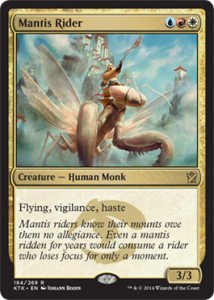
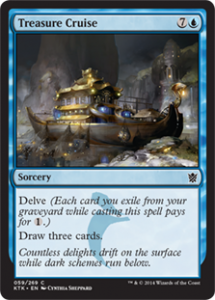
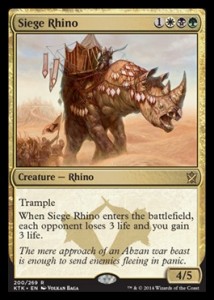
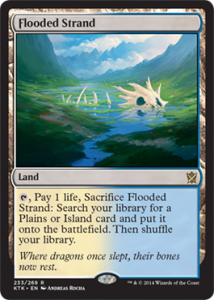
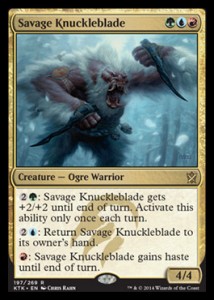
2 comments on Casually Infinite – Preserving Khans for Future Play